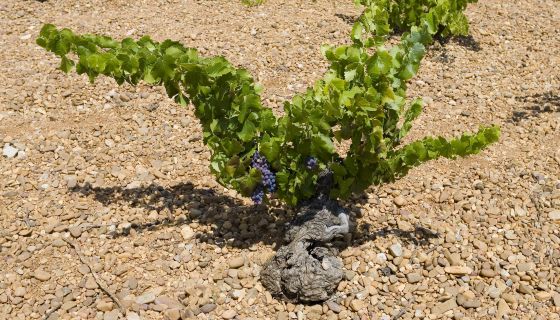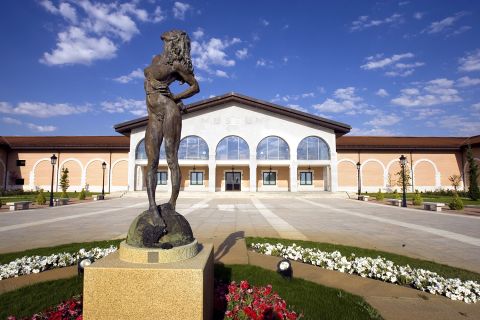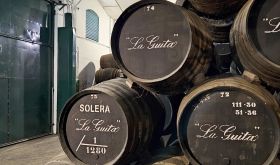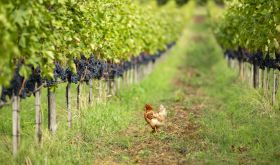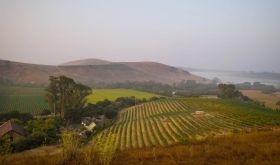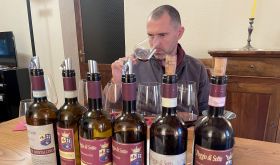1 December 2023 An underpriced, complex red made from rescued Spanish vines that are nearly a century old.
From €15.29, £22
In late 2009, tacked on to a visit to Rioja, I explored a small, relatively unknown wine region just west of Ribera del Duero, Cigales (see your online map of Spain for its location). The region was fascinatingly distinctive and the result was this (free) overview and this tasting article.
Forgive me for quoting from that overview to give you the bare bones of the region:
‘The great advantage of Cigales’ never having been a dynamic wine region is that viticultural methods have remained doggedly traditional. The climate is dry and harsh. At 650–800 m altitude, and with relatively low rainfall, agrochemicals have rarely been used to any great extent. Drought and frost are the chief enemies of the vine here, not disease. Cigales is higher and cooler than Toro to the west so its wines tend to be rather more structured. It is much smaller and very much less famous than Ribera del Duero to the east, so land and wines tend to be considerably less expensive. But the best of them seem to have very promising ageing potential and – a big mark in their favour in my book – very few of them suffer the over-oaking that seems endemic in status-conscious Ribera del Duero.
‘There is the other advantage that, since most growers have treated their holdings as a hobby, there has been little incentive to keep replanting vines, so that more than half of them are more than 60 years old.’
As you can see from my tasting notes, the most impressive wines by far in 2009 were made from the region’s oldest vines. Valdelosfrailes’ single-vineyard 2003 from Pago de las Costanas and Traslanzas 2005, from vines planted in the 19th century and 1945 respectively, were the standouts and I went on to make Traslanzas 2003/2005 wines of the week.
I was hugely impressed by the potential of this region back in 2009 but since then, we have published the grand total of one tasting note on a wine from the region, a 2013 imported into the UK by Vin Cognito that Tam tasted in April this year. Until last month when I had the chance to taste a current range of wines from by far the biggest and most sophisticated producer in the region, Finca Museum, which has resulted in this wine of the week.
The thing that distinguished the region during my visit there, apart from a climate that was as harsh as the soils, was the network of underground cellars burrowed into the rock (likened to concrete by Finca Museum’s Jaime Echevarri) under the Cigales villages by small-scale family vine-growers. All this was so obviously homespun, I suspected that few of them realised what treasures their old vines represented.
In the early years of this century it must therefore have been a huge shock for the region when the company that owns Baron de Ley in Rioja, responsible for Spain’s best-selling Rioja El Coto, moved in. (They meant to diversify into Ribera del Duero but left it too late to buy anything they thought sensibly priced.) Although I could see what attracted the outsiders to the region, what I was shocked by was their winery: a huge, above-ground temple (see above) with, during my visit anyway, just a single row of barrels on the vast floor space that would presumably use up horrendous amounts of energy keeping it sufficiently cool during the region’s hot summer days. Quite a contrast to those underground tunnels – although I see that last month Finca Museum was certified as sustainable, so presumably some solar panels or suchlike have been added.
By dint of careful negotiation with dozens of suspicious smallholders, the company now owns 185 ha (457 acres) of vineyards with a further 100 ha of smallholders’ old bush vines from which they buy on long-term contracts.
In the old days the region mainly produced slightly rustic, strong, dry rosados based on a blend of the dominant Tinta Fina, or Tempranillo (thought to resemble that grown in Toro more than the Ribera del Duero biotype), with local white wine grapes such as Albillo. This was a favourite in the bars of nearby Valladolid. I was impressed by the Finca Museum, Rosé 2022 Cigales I tasted last month. Tempranillo with 10% Verdejo, it has masses more character than most rosés (I note it’s labelled rosé not rosado).
I also tasted Finca Museum, Vinea Tempranillo Crianza 2020 Cigales from 50-year-old bush vines aged in 60% American and 40% French oak and gave that a score of 16.5, too, finding the sweet spiciness of the oak a complement rather than an intrusion. The French-oak-matured Finca Museum, Museum Reserva 2019 Cigales from 70-year-old Tempranillo bush vines I liked even more (except for its quite unnecessarily heavy bottle).
But the real star was the thoroughly intriguing Finca Museum, La Renacida 2019 Cigales, a field blend from an ancient vineyard at nearly 800 m (2,620 ft) elevation recuperated by the company, renacida meaning reborn. The 2.94-ha (7.26-acre) vineyard, originally planted with a great mix of varieties in 1927, had apparently been abandoned. Even now it produces only about three tonnes per hectare of especially concentrated fruit – although the alcohol level of this 2019 is only 13%, perhaps helped by the relatively mild, occasionally rainy 2019 growing season.
It must have taken quite a bit of detective work and careful calculation to come up with the assemblage: 35% Tempranillo, 20% Albillo Mayor, 20% Garnacha Tinta,15% Verdejo, 5% Garnacha Blanca, 3% Bobal and 2% Mencía, all destemmed and co-fermented. Winemaker David González oversaw a spontaneous fermentation and malolactic conversion and aged the blend for 12 months in French foudre. I really enjoyed the result and gave it 17.5/20, suggesting drink dates of 2022–2032 with this note:
Heady, complex nose with a certain relaxed quality about it, as though the vines know they are superior and have been spared winemaker intrusion. Complete, sweet and lively. Considering that wine from vines this old from anywhere else would probably cost much, much more, this is VGV.
A word on that sweetness. The tech spec cites the residual sugar as 5 g/l which is a bit high (and may help to explain the relatively modest alcohol) but there is such a lot going on here that the result certainly doesn’t taste like a simple sweet red.
The wine is quite well stocked in the UK with Wine-Searcher citing five stockists (and Liberty supplying so many smaller independents that it’s likely to be even better distributed). La Renacida seems to be particularly popular in the Netherlands and is also available, according to Wine-Searcher, in Belgium, Poland, Slovakia and Switzerland (with some variation of vintages) – as well of course as in Spain, where it is practically given away.
Wine-Searcher do not currently list any stockists of La Renacida in the US alas. Finca Museum wines are currently represented there by Carolina Wine Brands who will hand over to Opici Wines and Spirits in March and the plan is to launch the 2021 La Renacida then. I am told I am being sent a bottle to taste and will post my impressions here once that happens. I urge those of you in the US to look out for this lovely wine.
Later on 1 December I have just tasted the 2021 and it's more delicate than the 2019 but no less charming and convincing. See my tasting note.

